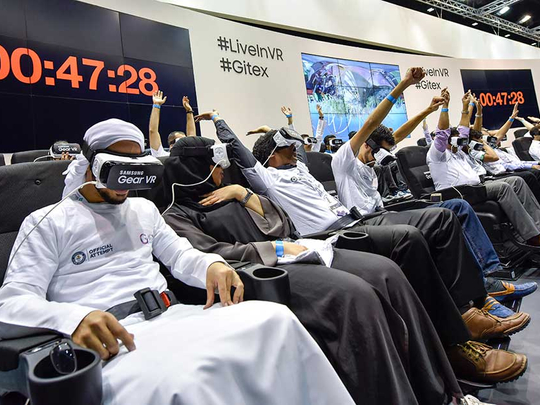
By Sarah Algethami, Staff Reporter
Dubai: These days, you don’t have to visit a theme park to ride a roller coaster, thanks to virtual reality (VR) technology.
On Monday, scores of visitors at Gitex Technology Week, taking place at the Dubai World Trade Centre (DWTC), queued to experience riding a virtual reality roller coaster. Visitors filled the 32 4D motion chair virtual reality theatre set up by the DWTC, with 461 riders helping establish a new Guinness World Record for the most participants to ride a virtual reality roller coaster in one hour. The seats rocked to give the effect that the participants, wearing Samsung Gear VR headsets, were on a roller coaster.
Leaving the theatre, Fatima Tariq, a Dubai resident, said the experience was “amazing”, adding that she had “tried virtual reality before but not in a setting like this”.
Baber Javed, a tourist from Pakistan, said while he enjoyed the virtual reality ride, the picture quality was not very clear.
“The feeling of actually being on a roller coaster was there. The only downside was that the resolution and picture quality wasn’t very clear. The Sony [PlayStation VR] has a better resolution, but this had a wider field of view,” he said.
The virtual reality theatre is a first for Gitex Technology Week. “We want to have an accreditation where we are recorded in the Guinness Book of World Records,” Jessie Ng, director of live events and creative strategy at DWTC, told Gulf News at the exhibition.
The virtual and augmented reality technology market could be worth a trillion dollars by 2035, according to a report by the analysis unit of investment bank Citi, released earlier this month.
“VR/AR is now firmly on the radar as an investment theme and is expanding as an industry and we believe it will be used in a wide range of applications and in a number of different industries going forward,” Citi said in the report.
Besides Samsung’s Gear VR, this year has seen the launch of other virtual reality headsets by competitors, including the Oculus Rift, HTC Vive and Sony’s PlayStation VR.
Alongside gaming, Citi predicts that the market will expand to include content that allows consumers to visit concerts, zoos and theme parks, and watch movies and television shows.
Hardware, mainly virtual reality headsets for gaming, will be the driver of the industry’s growth, with the overall virtual and augmented reality market likely to reach $692 billion by 2025, according to Citi.
“Given the global e-commerce and m-commerce market is currently around $1 trillion, and is expected to rise to $4 trillion by 2030, even if VR/AR only gets a small percentage of the market, it would be a significant driver to the growth of the VR/AR market overall.”
Global consultancy Deloitte expects 2.5 million virtual reality headsets to be sold in 2016, according to a report published last August. Meanwhile, research firm CCS Insight predicts that 24 million virtual and augmented reality devices will be sold by 2018.












